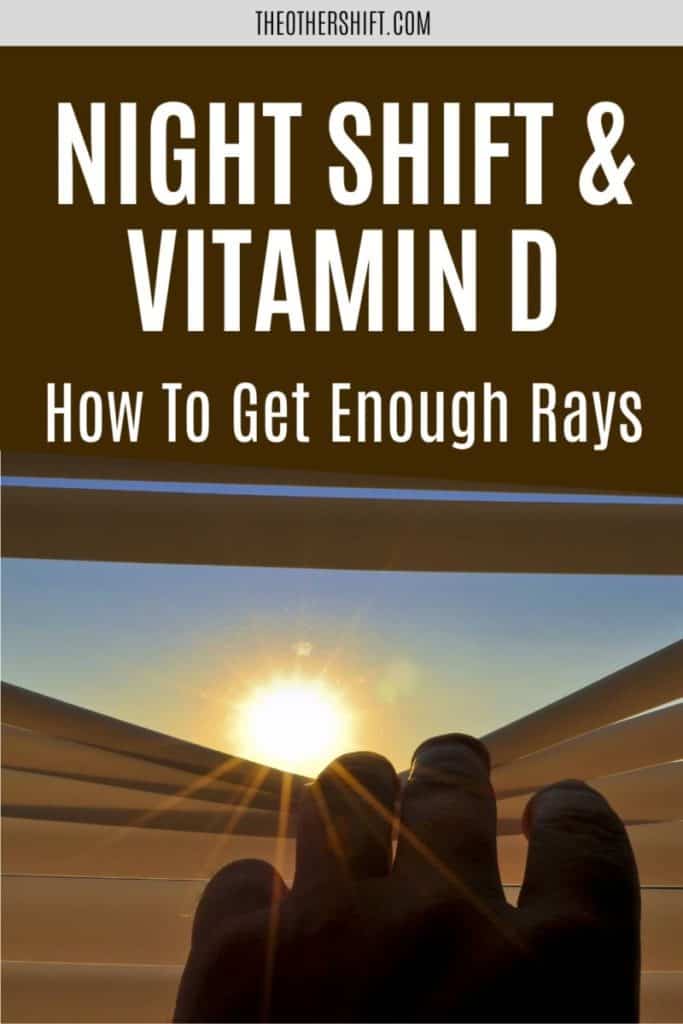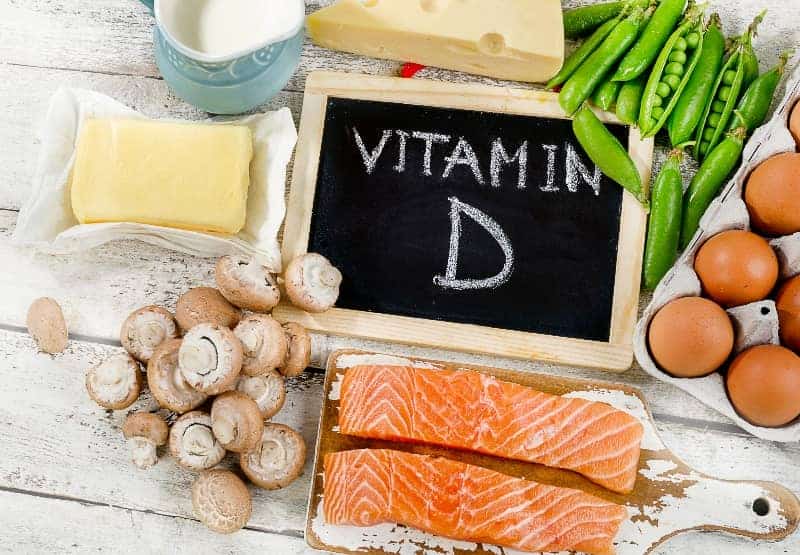Disclosure: This page may contain affiliate links, meaning we receive a commission if you decide to make a purchase through our links, but this is at no additional cost to you. Please read our disclosure and privacy statement for more info.
Vitamin D is important because it helps to keep our immune systems in tip-top shape, it also ensures that our bones are healthy and strong. Yet, vitamin D insufficiency affects nearly half of the world population and night shift workers have an even higher predilection for vitamin D deficiency. So, if the night shift has you feeling like a bit of a vampire, it might be because you need some more vitamin D.
To achieve the optimal level of vitamin D exposure, night shift workers need to spend at least 30 minutes outside in the sun three times a week. If this is not possible, increasing your intake of vitamin D rich foods or taking a vitamin D supplement is recommended.

We are firm believers in taking a balanced, wholistic approach to health, and since vitamin D deficiency affects so many of us night shift workers, we felt it important that our readers are equipped with a deeper understanding of what vitamin D does, how it is produced, and how to safely ensure you are getting enough to foster your greatest health and alignment.
Vitamin D And The Night Shift
Vitamin D, also known as the sunshine vitamin, is naturally produced by our bodies when they are exposed to UVB rays from the sun. That said, night shift workers are at risk of becoming vitamin D deficient because the biggest part of our day takes place after sunset and we tend to be sleeping during the strongest daylight.
This means we may have to work a little harder, than our friends working the day shift, to make sure we are getting enough sunlight exposure to produce vitamin D.
Though it is also good to note that day shift workers are also at risk of becoming vitamin D deficient. This is due to the fact that, the UVB rays, which activate the skin’s vitamin D production, cannot penetrate most modern windows. So even if the sun is streaming into your workplace, you are likely not reaping the benefits of vitamin D.
Vitamin D’s role in fighting disease, reducing depression, and aiding weight management make it an important part of any shift worker’s healthy lifestyle, so we want to make sure you know how to go about getting your fill of vitamin sunshine.
You may also be interested in: Which vitamins Should I take on Night Shift?
First, a word of caution. It is always a good idea to discuss new behaviors with your doctor when it comes to vitamin intake. This is especially true if you are taking prescription medications for preexisting conditions, as certain vitamins and supplements can interfere with your prescription therapies.
Okay, with that out of the way, let’s jump in!

What is Vitamin D?
Vitamin D is actually more than one vitamin, it is a family of vitamins that share a common chemical structure. When we discuss vitamin D we are primarily talking about vitamins D2 and D3.
Vitamin D2 is also known as ergocalciferol. It is primarily found in plants and fortified foods, like mushrooms that have been grown under UV light, or Vitamin D fortified orange juice.
Vitamin D3 is also known as cholecalciferol. It is primarily found in fish, egg yolks, butter, dietary supplements, and it is the type of vitamin D that is naturally produced by your body when exposed to UVB radiation.
Vitamin D in the Body
Both vitamin Ds are fat-soluble, meaning they are stored and transported in fatty tissues and will remain in our bodies for a longer period of time than water-soluble vitamins. This is why there is really no reason to top-off your vitamin D on a daily basis unless directed to by a doctor.
Once vitamin D enters the body either through consumption or absorption it is the liver metabolizes it in to calcifediol, which is the circulating form of Vitamin D.
Note: If you want to have your Vitamin D levels measured by your doctor you have to ask for a calcifediol panel.
The Benefits of Vitamin D
Vitamin D, calcifediol, plays a vital role in regulating the absorption of calcium and phosphorus but there are a number of other ways that vitamin D benefits shift workers.
- Vitamin D fights the flu: According to a 2010 study, adequate vitamin D levels were linked to a lower risk of developing severe flu symptoms.
- Vitamin D reduces your risk of heart disease: A 2008 study found that vitamin D plays a role in decreasing risks associate with heart disease.
- Vitamin D prevents seasonal affective disorder and depression: Findings from several studies have documented symptom reduction among depression patients after receiving vitamin D supplements.
- Vitamin D is a preventative: Vitamin D Deficiency (VDD) is associated with a number of chronic illnesses, including cancer, multiple sclerosis (MS), and other autoimmune disorders. Getting enough vitamin D is, therefore, an important preventative measure to ensure your long-term health.

Vitamin D-ficiency (VDD)
Vitamin D Deficiency occurs when your body’s calcifediol levels fall below 20 ng/ml.
The symptoms of VDD can be subtle and are often mistaken or ignored. That said, VDD is common. According to a 2011 study, 41.6% of adults in the United States are experiencing VDD.
Common symptoms of VDD include:
- Osteomalacia: Due to vitamin D’s role in calcium absorption, deficiency can lead to a painful softening of the bones, known as Osteomalacia. This often manifests as leg and back pain. In extreme cases vitamin D deficiency can even lead to bone loss.
- Weakened immune system: If you are getting sick more often than usual it might be related to VDD.
- Fatigue: Shift work causes fatigue too, but if you are more tired than usual it could be due to VDD. A case study found that when critically deficient patients supplemented their vitamin D levels their fatigue resolved.
- Depression: Vitamin D levels may be linked to seasonal depression, which explains why some people are affected by Seasonal Affective Disorder. (Check out Night Shift and Depression. Are They Linked?)
- Impaired healing: Is that papercut healing slower than usual? VDD might be to blame. An experimental study found that vitamin D helps to increase the production of new skin.
- Hair Loss: Low vitamin D and iron levels have been linked to hair loss in women. This is likely due to VDD’s association with autoimmune diseases like Alopecia areata and rickets.
- Muscle Pain: 71% of people who reported VDD also reported chronic pain, so it is safe to assume there is a correlation. Scientists have also discovered that there is a vitamin D receptor present in nociceptors, meaning that VDD lowers pain tolerance. (Check out Why Does My Body Ache After Night Shift?)
Sounds like the symptoms of shift work, right? It is highly likely that you are vitamin D deficient if you have experienced any of these symptoms and have not achieved satisfactory relief with other therapies.

Who Is At Risk of Developing VDD?
While it is estimated that 50% of the adult population of the world is vitamin D deficient, not all adults share the same risk. There are a number of factors that can make you more likely to experience VDD.
These factors include:
- Skin tone: Melanin can inhibit vitamin D production, meaning that people with darker skin need to spend more time in the sun to produce vitamin D than those with lighter complexations.
- Age: As we get older our skin’s ability to produce vitamin D is decreased.
- Geographical location: The further you live from the equator the less UVB rays you receive throughout the year. This is due to the fact that the sun tilts away from the sun at various points throughout its orbital year, creating the seasons.
- Indoor lifestyles: If you spend most of your time indoors you are more likely to become vitamin D deficient.
- Medically prescribed sun avoidance: Some people may not be able to spend time in the sun due to pre-existing medical conditions such as lupus, or a susceptibility to skin cancer. If this is the case, you are also at a higher risk of developing VDD.
Long-term vitamin D deficiency can lead to a host of negative health effects, since vitamin D deficiency is correlated with a number of adverse health conditions including cancer, auto-immune disorders, and bone loss. For this reason, those at a higher risk of becoming vitamin D deficient need to be regularly monitoring their vitamin D blood levels and taking steps to prevent VDD.
How to Get Vitamin D from the Sun
The recommended dose of Vitamin D for adults up to age 70 is 600 IUs per day.
How Much Time to Spend in the Sun
Most people can produce enough vitamin D by spending about 30 minutes a day in midday sunlight. Midday sunlight has the most intense UVB rays, meaning your skin will be most efficient between the hours of 11am and 3pm.
According to a study in Advances in Experimental Medicine and Biology, the late afternoon sun is also more dangerous, and could increase your risk of burns and skin cancer, so it really is best to try to get your sun exposure in before 3pm.
Again, there are a few factors you should consider:
- Lighter complexed people should only spend about 10 minuets in strong sunlight to prevent damaging sunburns.
- Sunscreen blocks UVB radiation and therefore may prevent the skin from producing vitamin D.
- If you live further away from the equator you may not be able to get adequate UVB exposure during the winter months.
Experts recommend wearing a hat and putting sunscreen on your face before going out, especially if you plan to rest in the sun or sunbathe. You should expose about one third of your skin to the sun. And if you plan on spending a longer time in the sun dermatologists recommend applying sunscreen after the first thirty minutes.
Strategies for Shift Workers
It can be hard for night shift workers to get enough vitamin D naturally. To help you out we brainstormed three strategies to help you out.
Strategy 1: Take a Power-Nap Outside
If you need to get a daytime powernap, consider taking your snooze outdoors with at least one third of your skin exposed to natural sunlight.
To achieve the perfect outside nap, make sure you have sunscreen on your face and bring an eye mask outside to cover your eyes. Since you risk over-sleeping and getting a sunburn it is a good idea to make sure you have a loud alarm on your cellphone to wake you up after 30 minutes.
Need more sleep tips? You’ll love this post – The Night Shift Power Nap: What You Need to Know
A US-based flight attendant recommended this strategy. She says she likes to crash for a powernap by the pool whenever she gets a warm-weather layover. But don’t skip out on the sunscreen if you plan to take a long nap outside. Sunburns are not fun to deal with while working the red-eye flight home.
Strategy 2: Take Daily Walks
If you are a day shifter, this could mean taking your dog for a quick walk after you get home. If you are a night shifter, it could mean going out for a refreshing power walk after your day sleep. (yes, it’s okay to exercise after a night shift! Read more about when you exercise on nights here.)
The key to making the most out of daily walks is to aim for 30 minuets outside during midday sun (between 11am and 3pm).
This strategy is fantastic because it also ensures you are getting in some daily cardio and reaping the health benefits from that habit.
Strategy 3: Opt Outside for Breaks or Days Off
A cumulative total of 30 minuets outside, just three times a week should be enough to help you keep your vitamin D levels in the healthy range.
A simple strategy for day shifters, therefore, is to simply get outside during your breaks instead of sitting in the break room. If you go out to eat with your colleagues on a nice day, opt for restaurants with outdoor seating.
Similarly, for night shifters, if you are meeting friends on you days off, choose activities and meet ups that are outdoors.

Getting Vitamin D from Food
If sitting out in the sun is not a possibility for you, you might be able to supplement your vitamin D by eating vitamin D rich foods.
To achieve best results you should aim to consume about 600-1000 IU per day depending on whether or not you are starting out deficient, or simply trying to prevent deficiency. You will also want to try to consume foods that a naturally rich in vitamin D3, rather than relying of vitamin D2 fortified foods, since your body is more efficient at activating vitamin D3 and converting it to calcifediol.
It is also good to note that milk is not always fortified with vitamin D. In certain countries, including the United Kingdom, milk is not fortified with vitamin D2. Whereas in the United States and Australia, it is possible to find vitamin D fortified dairy products.
Here are some examples of naturally vitamin D rich foods:
- Salmon: Just 3.5-ounces of farm raised Atlantic salmon contains 526 IU of vitamin D3. Wild-caught salmon has even more vitamin D, packing up to 988 IU in each 3.5-ounce serving.
- Herring: Fatty fishes are a great source of vitamin D, and Herring is no exception, packing 216 IU in a 3.5-ounce serving.
- Tuna: Continuing the fish theme, a single can of tuna contains 268 IU of vitamin D. It’s also a great source of vitamin K but should be consumed in moderation due to the presence of methylmercury.
- Egg yoks: A single egg yolk contains 37 IU of vitamin D. If you opt for pasture-raised or cage-free eggs, you are going to get even more vitamin D out of your eggs.
- Mushrooms: Mushrooms a great source of Vitamin D2, some wild mushroom varieties can have up to 2,300 IU of Vitamin D2 per serving! Making them a fantastic option for the vegans among us. Commercially grown mushrooms do not have much vitamin D however, since they are usually grown in the dark.
- Red Meat: Red meats, like pork, can contain between 100 and 150 IU of vitamin D per ounce.



Recommended Vitamin D Meal Plan
We live for meal-prepping on the blog. Therefore, we thought it might be helpful to suggest a vitamin D rich meal plan that you can incorporate into your rotation.
Breakfast
Breakfast is for vitamin D fortified foods including:
- A glass of vitamin D fortified orange juice: 50 IU
- A vitamin D fortified bowl of cereal with milk: 100 – 200 IU (depending on whether or not your milk is fortified).
- Vitamin D fortified yogurt: 60 IU
Total vitamin D: 310 IU
Lunch:
Try this Smoky Salmon Bagel Burger with Garlic-Dill Schmear for lunch!
- Salmon burger: 525 IU
- Cream cheese: 6 IU
Total vitamin D: 531 IU
Dinner:
This meal might not be everyone’s cup of tea, but this warm mushroom salad with cured egg yolks boasts serious vitamin D content.
- Egg yolk: 37 IU
- Wild shitake mushrooms: 786 IU
Total vitamin D: 823 IU
Total estimated vitamin D from meal plan: 1,664 IU
While this meal plan might not be accessible for everyone, it does demonstrate the fact that it is possible to get enough vitamin D from your food.
Here are some posts we wrote about meal prepping if you need some inspiration:
- 12 Valuable Meal Prep Tips for Busy Shift Workers
- Healthy Meals for Shift Workers (with Recipes and Videos)
- 9 Shift Work Meal Ideas (Easy and Freezable)
Vitamin D Supplements
Taking a vitamin D supplement can be a convenient way to boost your vitamin D levels if you are deficient. It can also be an easy way to prevent deficiency.
It is always best to talk to your doctor before incorporating new supplements into your health habits.
That said, if you live far away from the equator, a vitamin D supplement is recommended during the winter months. The National Health Service of the United Kingdom, for example, recommends that adults take a vitamin D supplement from October – February to make up for the lack of UVB radiation from the sun.
Most doctors recommend taking a vitamin D3 supplement should you decide to consider supplements. This is because the body is more effective at processing vitamin D3, and because it is usually higher quality than vitamin D2.
For most adults a daily dosage between 1,000 and 4,000 IU is safe for maintaining healthy levels of vitamin D in the absence of sun exposure. Though there are supplements available in higher dosages, they are designed for people with extreme deficiencies and are not recommended for long-term use.
I liked this video below by motivationaldoc. He talks about vitamin D supplements and what you need to know about taking it.
Vitamin D Toxicity
Vitamin D toxicity refers to the consequence of consuming too much supplemental vitamin D.
If you do take a supplement that is too high for you, you risk causing a buildup of calcium in your blood which can progress to bone pain and kidney problems including the formation of calcium stones.
It is not generally considered possible to develop vitamin D toxicity from vitamin D produced in the skin or from consuming vitamin D rich foods. Vitamin D toxicity is the result of improper use of vitamin D supplements.
Symptoms of Vitamin D Toxicity include:
- Nausea and vomiting
- Poor appetite
- Stomach pain and constipation or diarrhea
- Bone Loss
- Kidney failure
The bottom line is, talk to your doctor before starting yourself on a vitamin D supplement.
Vitamin D Myths: The Truth About Vitamin D
Now that we have covered the most important information about Vitamin D and how to make sure you are getting enough, let’s explore three common myths about vitamin D. Spoiler alert: all of these myths are false, and we want to make sure you know the truth in the face of misinformation.
Myth 1: The More the Merrier
Some people like to throw too much Vitamin D at their problems, hoping that it will resolve their fatigue, depression, and or chronic pain.
This is not, however the case. And given the discussion we just had about Vitamin D Toxicity, it should not be surprising to learn that doctors do not recommend taking a Vitamin D supplement if you already get enough from your diet and regular sun exposure.
Myth 2: Vitamin D Aids Weight Loss
While there is some scientific evidence to suggest that obesity is correlated with vitamin D deficiency. There is no evidence to suggest that fixing vitamin D deficiency magically helps to curb your appetite. Unfortunately.
That said, Dr. Michael Holick, MD, PhD, has noticed a correlation between healthy weights and sufficient vitamin D. However, he believes it is more likely that having adequate vitamin D levels promotes a healthier lifestyle by decreasing fatigue and depression, which in turn has a positive effect on weight management.
Myth 3: You Can Get Vitamin D from Light Therapy
Even reputable sources like Healthline have recommended using a UV lamp to stimulate the skin’s ability to produce Vitamin D. While it is technically possible, most doctors do not recommend using light therapy lamps for that purpose.
This is because you have to use a really strong UV lamp to stimulate adequate skin vitamin D production. For a UV therapy lamp to do anything it has to emit over 10,000 lux of UV light which can prevent a higher-than-recommended risk for developing skin cancer.
Similarly, while tanning beds theoretically can stimulate vitamin D production, they are not recommended due to their association with skin cancers.
Note: If you do use light therapy to treat seasonal affective disorder, you should look for a light that emits little to no UV light, as they are safer for long-term use.

Final Thoughts: Shift Work and Vitamin D
Vitamin D is such an important part of a healthy lifestyle and it does not have to be a daunting task to ensure you are getting enough. We hope this article has equipped you with enough information to take a balanced approach towards getting your vitamin D from the sun, from food, and from supplements (when absolutely necessary).
Now friends, go out and enjoy some sunshine!
Next up – Can A Person Live Without Sunlight? A Night Owls Must Read

Disclosure: This page may contain affiliate links, meaning we receive a commission if you decide to make a purchase through our links, but this is at no additional cost to you. Please read our disclosure and privacy statement for more info.
- Coppeta, Luca, et.al. “Are Shiftwork and Indoor Work Related to D3 Vitamin Deficiency? A systematic Review of Current Evidences.” Journal of Environmental and Public Health. 2018. Web.
- Clifford J. and A. Kozil. “Fat-Soluble Vitamins: A, D, E, and K.” Colorado State University Extension. Web.
- “The Benefits of Vitamin D.” Edited by Debra Rose Wilson, Ph.D., RN. Healthline. Apr 7, 2020. Web.
- Spritzler, Franziska. “8 Signs and Symptoms of Vitamin D Deficiency.” Healthline. Jul 23, 2018. Web.
- Raman, Ryan, MS, RD. “How to Safely Get Vitamin D from Sunlight.” Healthline. Apr 28, 2018. Web.
- Miller, Zoë. “14 foods that contain a surprising amount of vitamin D.” Insider. Dec 31, 2018. Web.
- Hill, Ansley, RD, LD. “7 Effective Ways to Increase Your Vitamin D Levels.” Healthline. Mar 17, 2019. Web.
- Moriarty, Colleen. “Vitamin D Myths ‘D’-bunked.” Yale Medicine. Mar 15, 2018. Web.
- Zeratsky, Katherine, RD, LD. “What is vitamin D toxicity? Should I be worried about taking supplements?” Mayo Clinic. Web.
- Barrie, Leslie. “11 Vitamin D Myths and Facts.” Everyday Health. Edited by Justin Laube, MD. Dec 8, 2020. Web.
Recent Posts
Too hot? Too noisy? Too bright? Too tired? This is common feedback we get from most night shift workers, when trying to get solid shut-eye during the day. So it's about time you got some help in the...

